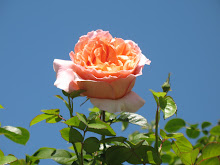

The apple varieties Anna and Dorset Golden thrive in Zone 23. Both require only about 150 hours of chilling a year, defined as temperature under 45 degrees, in order to bear fruit. Most apple varieties require 1,000 hours of chilling. Our Anna and Dorset Golden (for best results, plant one of each for cross-pollination) are true dwarves, each barely 5 feet tall after 10 years in the ground. This is in contrast to our supposed "dwarf" Mexican Lime, which requires aggressive annual thinning and topping to keep it below 7 - 8 feet tall.
Other than a deep soaking every week or so during the summer, the apple trees receive only surface watering from sprinklers (and of course natural rainfall). As commented on a previous post, this winter featured weeks of unusually cold weather that I would estimate far exceeded 150 total hours below 45 degrees. It's probably no coincidence then, that the two trees currently sport the healthiest-looking new foliage I've seen since they were planted. Furthermore, this was probably the only winter when both trees completely lost all of their leaves. So, although the two varieties will produce in our mild climate, they still appear to appreciate colder weather if provided. In addition to the foliage health, the blooms were unusually showy in January, and now the small "applets" are very healthy looking as well. In a few weeks, I'll thin the fruit so that the "chosen ones" will mature to a larger size come early summer, when they are ready to enjoy. I highly recommend these two varieties of apple for mild climate gardening.










